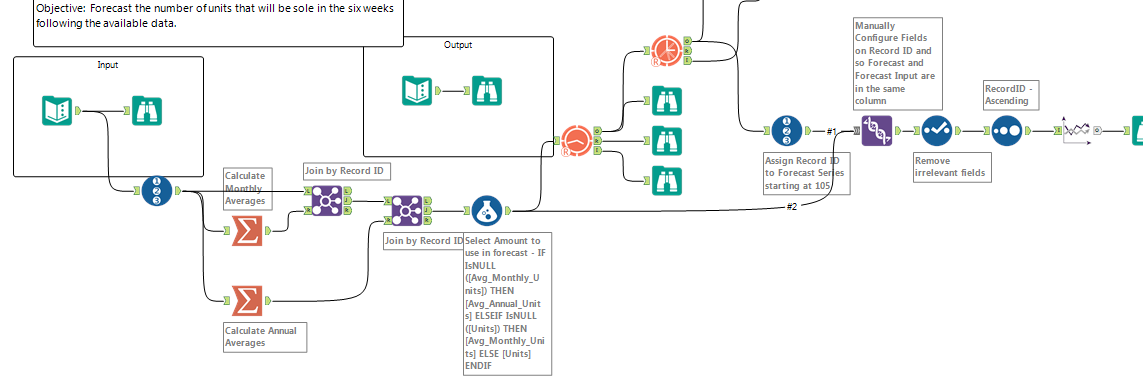Weekly Challenges
Solve the challenge, share your solution and summit the ranks of our Community!Also available in | Français | Português | Español | 日本語
IDEAS WANTED
Want to get involved? We're always looking for ideas and content for Weekly Challenges.
SUBMIT YOUR IDEA- Community
- :
- Community
- :
- Learn
- :
- Academy
- :
- Challenges & Quests
- :
- Weekly Challenges
- :
- Challenge #24: ARIMA Time Series
Challenge #24: ARIMA Time Series
- Subscribe to RSS Feed
- Mark Topic as New
- Mark Topic as Read
- Float this Topic for Current User
- Bookmark
- Subscribe
- Mute
- Printer Friendly Page
- Mark as New
- Bookmark
- Subscribe
- Mute
- Subscribe to RSS Feed
- Permalink
- Notify Moderator
For those of you following along, thank you, you can find the solution to last week’s challenge (challenge #23) is HERE.
This week’s challenge will use the predictive time series tool called ARIMA. If you don’t have the predictive tools you can find the installer at http://downloads.alteryx.com/downloads.html look for the link to “Predictive tools only”. The predictive tools in Alteryx execute the analytics in an open source application called ‘R’, the advantage of using Alteryx vs. R is that Alteryx provides a straight-forward user interface and eliminates the need to program directly in the R language. If you want to read more about what is happening under the hood, here is a link to the Wiki on ARIMA. https://en.wikipedia.org/wiki/Autoregressive_integrated_moving_average
The use case: A retailer would like to forecast how many units of a particular product will be purchased from their locations based on a historical trend.
The source data contains weekly data for 2012 and 2013 details how many units have been moved. Some of the data, however, is populated with NULL values. For the NULL values, please assign the monthly average. If the monthly average is also NULL, assign the annual average.
Objective: Forecast the number of units that will be sold in the six weeks following the available data.
Have fun!
- Mark as New
- Bookmark
- Subscribe
- Mute
- Subscribe to RSS Feed
- Permalink
- Notify Moderator
I arrived at the same answer, but I'm not sure it's the best answer. Based on the historical data, the forecast doesn't adjust for the drop off in sales each January. How would we configure the tool for a better answer? See spoilers below have the workflow plus what I came up when I exported to Tableau.

I added the the forecast back to the original data and came up with this chart in Alteryx. See how forecast did not adjust to prior January trends.

This is the data presented in Tableua plus the forecast solution that Tableau provided using the default settings.
- Mark as New
- Bookmark
- Subscribe
- Mute
- Subscribe to RSS Feed
- Permalink
- Notify Moderator
- Mark as New
- Bookmark
- Subscribe
- Mute
- Subscribe to RSS Feed
- Permalink
- Notify Moderator
- Mark as New
- Bookmark
- Subscribe
- Mute
- Subscribe to RSS Feed
- Permalink
- Notify Moderator
- Mark as New
- Bookmark
- Subscribe
- Mute
- Subscribe to RSS Feed
- Permalink
- Notify Moderator
My solution! I like these Time Series predictive tools, pretty intuitive (especially for someone who never uses predictive analytics!)

- Mark as New
- Bookmark
- Subscribe
- Mute
- Subscribe to RSS Feed
- Permalink
- Notify Moderator

- Mark as New
- Bookmark
- Subscribe
- Mute
- Subscribe to RSS Feed
- Permalink
- Notify Moderator
- Mark as New
- Bookmark
- Subscribe
- Mute
- Subscribe to RSS Feed
- Permalink
- Notify Moderator
I've not really explored the TS Tools (except TS Filler), I ended up with the same solution as other however, my forecast scores are correct but the confidence scores are slightly out and I can't see why?
- Mark as New
- Bookmark
- Subscribe
- Mute
- Subscribe to RSS Feed
- Permalink
- Notify Moderator
-
Advanced
301 -
Apps
26 -
Basic
158 -
Calgary
1 -
Core
157 -
Data Analysis
185 -
Data Cleansing
5 -
Data Investigation
7 -
Data Parsing
14 -
Data Preparation
238 -
Developer
36 -
Difficult
86 -
Expert
16 -
Foundation
13 -
Interface
39 -
Intermediate
268 -
Join
211 -
Macros
62 -
Parse
141 -
Predictive
20 -
Predictive Analysis
14 -
Preparation
272 -
Reporting
55 -
Reporting and Visualization
16 -
Spatial
60 -
Spatial Analysis
52 -
Time Series
1 -
Transform
227
- « Previous
- Next »




